CHAPTER IV
COMPLACENCY
1900 – 1930
As the 20th century opened, a new kind of prosperity came to Pittsfield. A feeling of complacency that comes from inherited wealth seemed to envelop the populace. There were not many hardship cases; almost everybody had security; that is, a home which they owned and a job that was sufficient to enable them to live comfortably without too many financial worries. Even those who rented mill cottages did not worry too much because they knew that when the seasonal slack came and the mill closed down, Mr. Dobson would be understanding and lenient. There was continued growth, but it was more from the momentum of the 80’s and 90’s than from a driving urge to forge ahead and catch up with that dream of industrial expansion. The past twenty years had been a boom economy that we often associate with pioneer days—a vigorous, rough, hard-hitting economy that couldn’t wait for the plateau periods—an overwhelming ambition to get ahead in the world of business and establish a comfortable place in which to live out the sunset years. They had no paternalistic government to look to for help if they failed in their drive for security. Now, as the new century begins, these good people with their mills running at capacity, with their bank established, with their stores enjoying better than average patronage, their schools gaining in prestige, and their churches comfortable and beautiful, is it any wonder that there was a complacency that comes from a job well done? With the boys back home from the war with Spain, with the ball teams winning consistently, and the pleasures of Sebasticook Lake and Moose Pond ever beckoning, what could be more natural than to “let down” a bit and enjoy a period of gracious living? This was the spirit that seemed to drift gradually over our town and enfold it until World War I shook everyone out of his lethargy.
There is one thing that must be mentioned at this point. Something was happening that most people failed to realize at the time. While the native population was just about to “rest on their laurels”, a few young Italian families, fresh from the mother
88
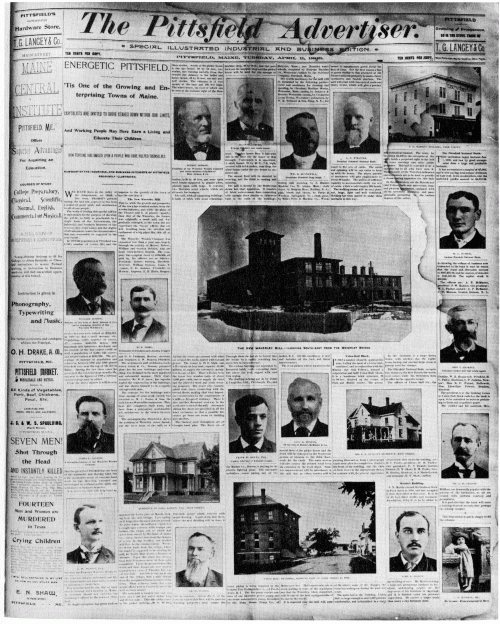
[Page 88.1]
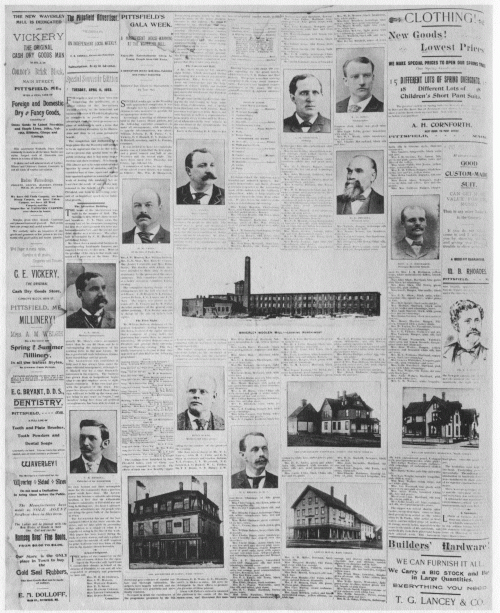
[Page 88.2]
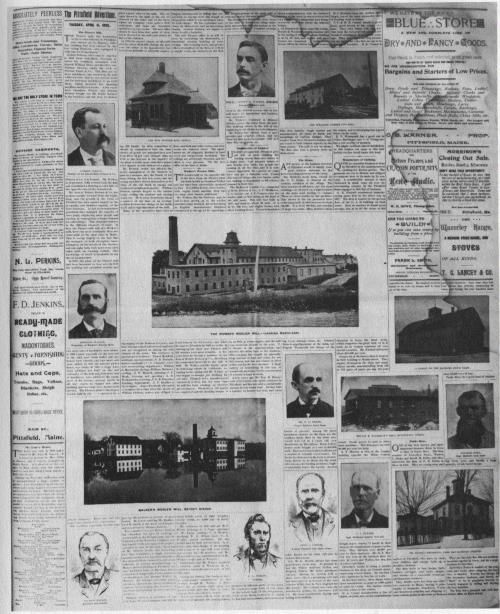
[Page 88.3]
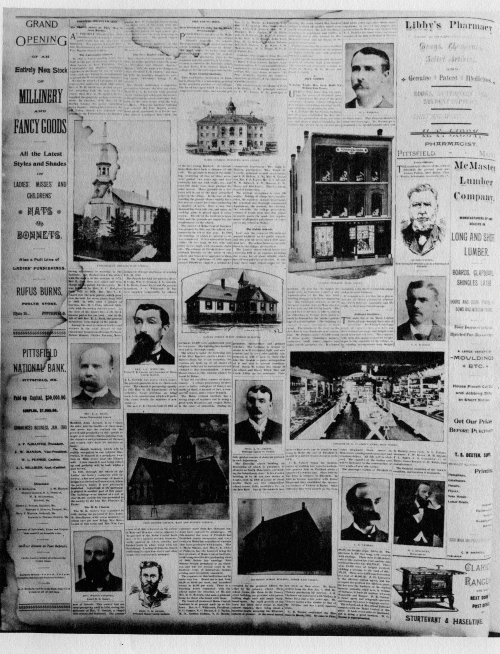
[Page 88.4]
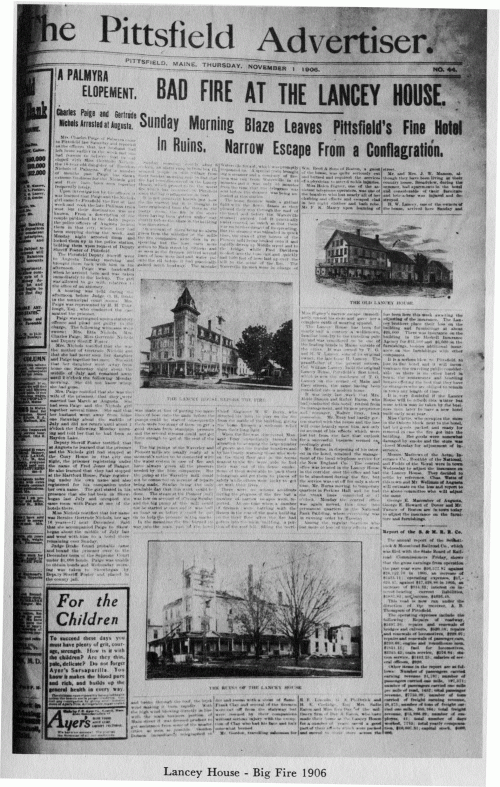
[Page 88.5]
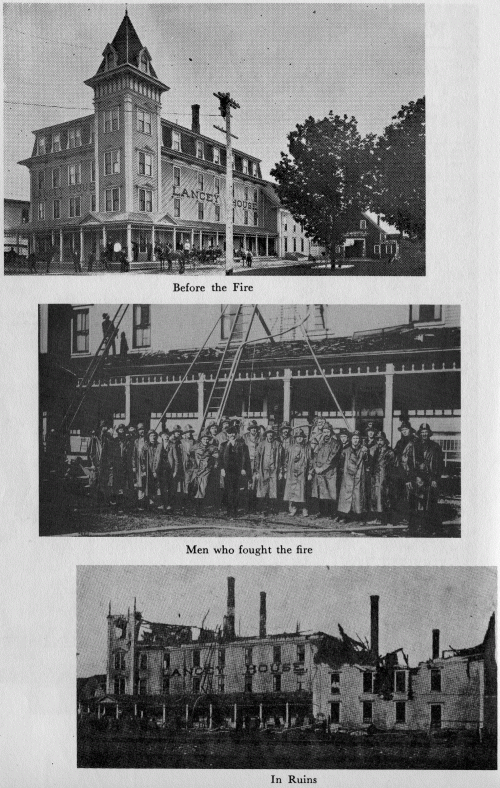
[Page 88.6]
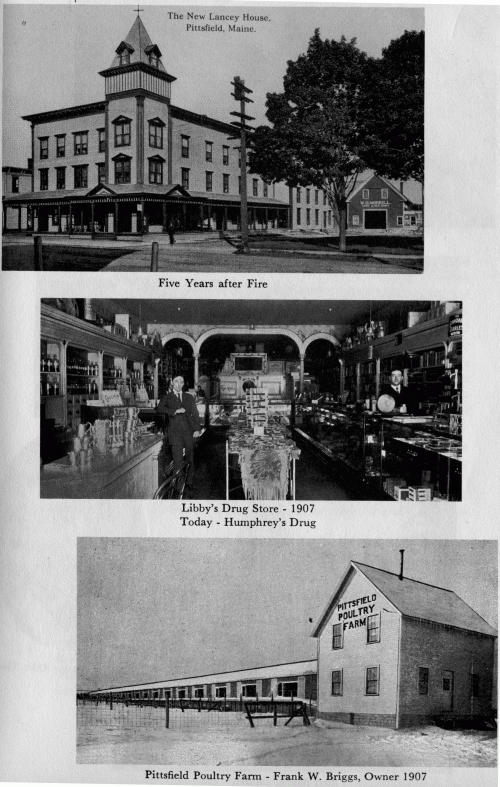
[Page 88.7]
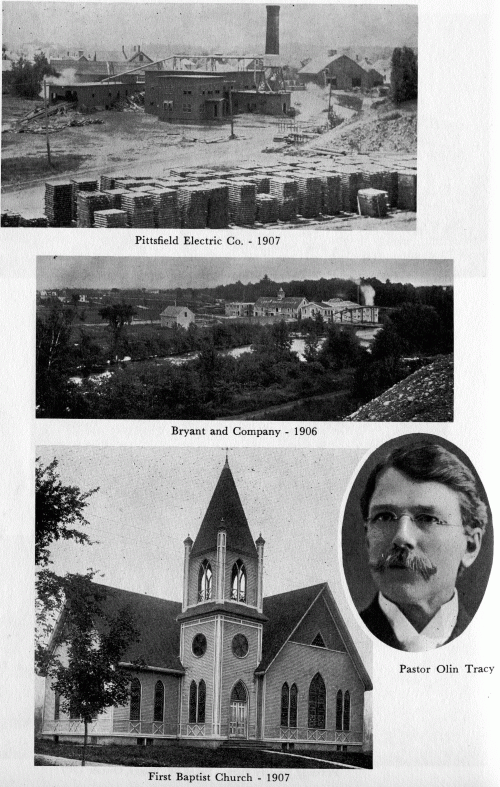
[Page 88.8]
country and filled with the same zeal and courage that were characteristic of our earlier pioneers, found residence on farms in the southern area of our township. Some had come to Pittsfield at the call of a relative and neighbor who had emigrated earlier and had found work for them here in the United States. One young Italian by the name of Dominic M. Susi from Sulmona, Italy, came to this country in 1894 and after a rather rough time getting adjusted, finally found his place here in the construction field and sent back home for help. In the next few years Pittsfield was to hear a lot about this aggressive young man and the influence he exerted in our town. It is a most interesting story.
In 1900 one of the most active businesses was the Pittsfield Electric Light and Power Company. It was located on the north side of the Mill Pond in a building known locally as The Old Soldiers Home because, so the writer has been told, men soldiered on the job when it was under construction. The Power Company itself was no laggard. Besides furnishing lights for more and more residences and business places, it had eight departments of lumbering. It was cutting and sawing around two million feet annually, using two hundred thousand feet of white birch to supply Hollingsworth and Whitney plugs and shipping 32 cars of products to New Jersey.
Another woodworking plant doing very well at this time was the Bryant Company. In addition to its usual business of building supplies, it had taken on the job of building the new canning factory which it finished in August of 1900. J. F. Connor had solicited funds and J. W. Moses, “a hustler, ” became superintendent of this new industry.
Other events of interest to take place this first year of the new century was the dedication of the Masonic Hall on the upper floor of Union Hall and across from the I.O.O.F. quarters. Union Hall lost a tenant when the bank moved to the Manson Block on the east side of Main Street. There was a new sidewalk on the east side of Main Street from the Dobsons to Nichols Street, and a new sewer was constructed on the west side of town through Hathorn field south 2600. The Dobson-McMaster monument was placed in the cemetery and it was a most impressive memorial. The Fire Department came in for a lot of praise. D. M. Parks was Chief Engineer
89
and he was an inspiring leader. S. S. Smith leased a building on Lancey Street for a carriage shop. Mr. Smith’s father, S. E. Smith, was well-known for his penmanship. He taught writing and for sometime did the diplomas for M. C. I. His exquisite lettering can still be found on some of these old diplomas. The writer has spent many hours watching Mr. Smith draw the fine lines decorating some of his beautiful carriages, which in later years he built in his carriage shop in Palmyra. He was an artist in his profession.
To conclude this first year of the 20th century on a happy note, Rufus Burns and Edith Gardiner were married in October. Mr. Burns at one time managed the Lancey House.
During the next two years, the elements went on a rampage in both the winter and spring. In 1901, the S. &. M. R. R. was snowed in so badly that help had to be summoned from Portland. The outlying roads and village streets were almost impassable and, of course, the natural sequence was high water in the Spring. It was a reminder of the flood of 1887 and there was quite a bit of comment that, although the 1901 flood was almost as severe as in 1887, the damage was much less because of the precautions that were taken following the earlier overflow. The following year, however, another spell of flood waters came and took out four bridges. The Sibley Bridge, which everyone expected to go, just seemed to ride the crests and settled back as the waters receded.
In 1901, A. H. Danforth moved into the store next to Libby’s Drug Store; the Pittsfield Electric Light and Power Company continued to be very active; Rev. Olin Tracy came to the Baptist Church to begin what proved to be an outstanding pastorate; Capt. Parsons was doing a thriving business taking parties to popular Camp Ringwood; more improvements were made at the Lancey Home; and a great deal of talk was going around about developing the water power at the 30 mile rips below Pittsfield. L. O. Haskell who had taken over the editorship of The Advertiser in 1896, was devoting more space to social notices and entertainments at Union Hall. The U. L. A. S. and the Tuesday Club were especially active.
In 1902, it was noted that there were now four active churches in Pittsfield. The Christian Science followers were meeting at Perkins Hall, while the other three had their own places of worship.
90
The Universalist, Baptist and Methodist all seemed to be enjoying good attendance.
PUBLIC LIBRARY
The library came in for considerable discussion about this time. It was overcrowded and inconvenient. The interest in this problem was further heightened when it was learned that Andrew Carnegie had offered a delegation from Pittsfield a gift of $15,000 for a new building. A committee made up of C. E. Vickery, Frank Weeks, William Dobson, O. H. Drake, Oramel Murray and F. Smith, was chosen to consider Mr. Carnegie’s offer. It was nearly a year later before a final decision was made to accept the gift. First there was a question of location. Mr. T. G. Lancey had offered the lot on the corner of Main and R. R. Streets where the old carriage shop had set and later removed by T. G. ‘s father, Isaac. Mr. F. Frank Smith did not like this location because he felt that it was too near the railroad tracks and, therefore, would be noisy, and also, being on the south side of the tracks, would get the smoke from the trains. He liked the Hackett lot at the corner of Park and Hathorn streets. This set off a real hassle and before it was over, the town had voted 240146 for the Hackett lot and then later rescinded the vote and went 253171 for the Lancey lot. William Dobson made an eloquent speech in favor of the latter site. The town next voted to accept $10,000 of the $15,000 offered. The reduction was made because of a provision in the offer that the town must agree to contribute 10% yearly of the amount accepted for the maintenance of the library, and the state statutes limited the amount Pittsfield could raise for such purpose to $1000. The library was now definitely on its way and within a year would be ready for dedication.
BURNHAM DAM
In October of this year (1903), the busiest place in Pittsfield was at the Burnham Dam, socalled. 265 men were working there and Ed. Mitchell, who had built the S. & M. R. R. in record time, had arrived with an additional crew of Indians. A new barracks was built for them known as “Little Italy.” D. M. Susi was active
91
in recruiting help and a few of these sons of Italy on this job stayed to become hardy citizens of our town. The Sebasticook Power Company, a $100,000 corporation, planned to spend $200,000 plus the cost of acquiring the old Pittsfield Electric Light and Power Company which was running into financial trouble. The officers of this latest power company were Allen Hackett, President; J. W. Manson, Secretary and Treasurer; Directors: C. B. Haskell, William Dobson, Gordon Dobson, T. G. Lancey, Hon. C. A. Milliken. This was a big job for those days. The dam was 72′ wide at the base, 12′ at the top, a 500′ penstock, a power house, G. E. machinery to develop 1200 to 1500 HP. More than 100 horses were required for excavating and trucking supplies. Percy Johnson was the boss and J. H. Burleigh, engineer.
RINGWOOD
Another project of this year of a somewhat different nature concerned the further development of Ringwood on the west side of the Sebasticook. Capt. Parsons and his famous boat “Winthrop” had been boating parties for picnics and the like to this lovely spot and now he decided to construct a dance pavilion 30 x 50 and lighted by a 750 candle power gasoline arc light for the pleasure of the area and profit to himself. He opened in July with afternoon and evening affairs. He made one trip to Hartland and half hourly trips to Waverley. 50 couples came in the afternoon and more than 100 couples in the evening. It was a most successful venture and provided great pleasure for the young and old alike.
Father Kealy, nonresident priest from Belfast, who was serving the local Catholics, brought forward the idea of building a church. To start the project, he suggested that he could get funds to match whatever the parish could raise up to $1000. Almost before he could get back home and return, the parish and friends of the parish had pledged more than $1100. This was the beginning of the movement that resulted in St. Agnes Church the following year.
Social life for the male population took a turn for the better about this time. The ladies had their clubs and parties for informal
92
relaxation, but the men didn’t seem to have comparable opportunities. Of course, both sexes had their churches and lodges, but these were more formal and not quite so much fun. So in 1902, the Somerset Club was organized with a meeting place over T. G. Lancey’s store. It was a man’s spot, fitted for cards, billiards, reading, and offering a quiet relaxed atmosphere. It proved very popular and the membership grew rapidly, even though it was run on an invitational basis. F. W. Briggs was President; H. F. Libby, Vice-President; and Sid Jones, Secretary and Treasurer.
To add to the male’s enjoyment at this period, a great interest developed in baseball. The M. C. I. team continued to win quite regularly over their regular opposition so when summer came around it was natural that many of the boys joined some of the nearby town teams. Pittsfield had a very good organization and at this particular time there was a strong rivalry between Pittsfield and Hartland. They played a series of games, first one winning and then the other. Large crowds attended these games and bet heavily. This series got more attention than Col. Morrill’s horse racing.
Four major events occurred in 1904 to make the year outstanding: The Grange building was dedicated; the Library and Soldiers’ Monument were dedicated; Rev. John Kealy held the first services in the newly-constructed St. Agnes Church; and the Grammar School building on North Lancey street was completed.
The Grange building was dedicated early in February and it was quite an occasion. There was an immense crowd with many prominent Grangers from out-of-town, including Obadiah Gardner, State Master. The officers of the local Grange who participated in the ceremonies were Master Foster, Overseer Everett Libby, Steward C. Russell Phinney, and Secretary Edith Phinney. Master Foster presented the keys to State Master Gardner who responded eloquently.
LIBRARY DEDICATED
The Soldiers Monument and the new Carnegie Library were dedicated on the same day early in June. The Stephen Davis Post Number 11 of the GAR had been active in securing the monument
93
for Pittsfield. It is a beautiful memorial as all can testify today. It cost $3300, and at that time it meant a lot of hard work on the part of the Post to raise that large amount. In the forenoon there was a parade from the GAR Hall to the Cemetery and back to the Hall. In the afternoon at 1 o’clock, the marchers reformed and went to the Library grounds where the dedication ceremonies were held in the presence of a large crowd. Later in the afternoon the Library dedication exercises were held in Union Hall. Welcome was given by Dr. E. C. Bryant; Invocation, Rev. O. H. Tracey; Delivery to trustees, Oramel Murray; Acceptance, William Dobson; Oration, Hon. Guy A. Ham; Benediction, Rev. A. E. Morris; Music, Singing America led by band.
ST. AGNES PARISH
On November 17, Father Kealy, the priest from Belfast who had worked so hard in the interest of his small but fast growing parish in Pittsfield, conducted the first services in the recently finished St. Agnes church. It must have been a thrilling moment for the 100 communicants who worshiped that clay. The building had cost $8000, $3200 of which was already paid in. The interior was finished in natural cypress, ornamented with oil paintings and beautiful stained windows which were gifts of Michael McCarthy. The architect was W. H. McGinty of Boston, and the contractor, Irving Towle.
To complete the year, Contractor L. E. Bradstreet of Hallowell pushed his men extra long hours to finish the new Grammar School on North Lancey Street. The foundation had been put in by the Cyr Brothers of Mainstream and by early December, the building was nearly ready. It was a goodsized brick structure 71 x 39 and cost approximately $15,000. Since then an addition on the east side has been put on and it is still serving our fast growing school population.
Among the personal items of interest in 1904 there was a story of Charlie Dustin still going strong driving some of the fastest horses in Maine. His first race was in 1875. Hollis Stitham and Alice Rouillard were married in January. In April, the Somerset Club put on a minstrel show two nights at Union Hall before a
94
sellout crowd. C. E. Vickery sold out his long established business to take over the Sebasticook Power Company. Just previously, a $40,000 fire had destroyed the Pittsfield Electric Light and Power Company and Mr. Vickery was to have his troubles before the year was out to provide power for the rapidly increasing number of subscribers. Later in the year, a ban on residential lights was put on from 11 p.m. to 4 a.m. Considerable grumbling, naturally. H. R. Coolidge left Livermore Falls in August of this year to join J. W. Manson in law practice. Bert Josylyn completed a most successful season in baseball with New Bedford in the New England League and signed with the Boston Americans. He was scheduled to take a barnstorming trip through the West with the Boston organization.
To conclude the year on a particularly happy note, Harry W. Lancey and Angie M. Knowles were married in a ceremony long remembered. Harry was something of a practical joker, so when he decided to leave his bachelor friends, the boys really went to town on him. They had placards on the street all day announcing the wedding and inviting everybody to attend. The bridal couple left amidst the greatest barrage of old shoes, rice and confetti ever seen in Pittsfield and when the train pulled out for the honeymoon trip, five hundred laughing, cheering citizens waved them goodbye and best wishes.
1904 had been a busy and progressive year, more like the days of the 80s and 90s. It was estimated by The Advertiser that there had been $400,000 spent in building and repairing, although some of the projects listed were not completed until 1905. The Pittsfield Electric Light and Power Company had rebuilt again but its operation was somewhat curtailed.
At the beginning of 1905, the town was shocked and deeply saddened when it learned of the sudden death of William Dobson. He had been in apparent good health and was on a business trip down state when he was stricken in Waterville with acute indigestion. His passing was mourned throughout New England, but it was his home town, where he had known everyone for his friend, that felt the greatest grief. The funeral services at his home were simple and most impressive.
95
BANKS MAKE NEWS
In March, the Pittsfield National Bank moved into its new quarters in the old Connor block on the west side of Main Street. A complete renovation job had been done on the south side of the building to accommodate the bank and the interior arrangement and finish were described as the finest in the state. Since these facilities were not altered until recently, many can recall how they looked.
However, the Pittsfield National Bank was to have a competitor for the first time. On April 20th, the Pittsfield Trust Company met to organize and elected J. M. Chalmers, President; C. E. Vickery, Vice-President; Treasurer, W. H. Pushor; Executive Committee, Chalmers, Vickery, Coons, Llewellyn Parks, and F. R. Smith.
About this time there was another big fire on the west side of Main Street. It started in the Dudley Drug Store and severely damaged W. H. Davis place, Whitten’s tobacco store, and Graves Barber Shop, while south of Dudley’s, the stores of Mr. Gray and Mr. Vickery suffered smoke and water damage. There was a feeling that possibly some of these businesses might be replaced by brick blocks.
In December, Nat Gilman, Superintendent of Somerset Creameries, put on a great exhibition of dairy products in the Grange Hall. Mr. Gilman was a very able young man and had increased his business every year he had managed the creamery. As the year of 1905 ended, Benjamin Thompson resigned as American Express Agent after nineteen years of service. Previous to going with the Express Company he had been in the boot and shoe business. Throughout his life he had been active in civic life and his many friends wished him many pleasant years of retirement.
The following year there were two catastrophes in Pittsfield. In August, there was a very bad train wreck just below Farnham Brook when The Knickerbocker Express from New York to Bar Harbor collided with two freight cars left on the track. The engineer was killed and several trainmen severely injured. Wreckage was strewn over several acres of ground.
96
LANCEY HOUSE FIRE
Two months later, fire broke out at 6 a.m. in the pastry room of the Lancey House and swept up through the entire building, thoroughly gutting the inside of the three upper stories. The local fire department did a good job to contain the blaze in spite of the fact that they were somewhat handicapped in water supply. The telephone exchange in the Lancey House was knocked out so they had to send a telegram to Waterville for help. The Waterville steam pump was shipped to Pittsfield by train, but too late, of course, to save the hotel. Rufus Burns and Mrs. Damon had just resigned the week before and a Mr. Bray had taken over as manager. The loss was estimated to be $25,000.
In 1907, A. J. Loder compiled a Souvenir edition of Pittsfield. I am using some of the pictures from this issue since they illustrate so very well the condition of the town in this period. The public buildings, the business blocks, and the residences present a picture of prosperity and contentment.
The complacency of this period is becoming more and more evident as the years roll on. There seems to be a gradual slowing down of industrial progress. Those who can remember the era or whose parents have told them of these times may not agree with the writer, but the facts speak for themselves. The drive of the 80’s and 90’s was fading out. The giants of those halcyon days were getting old and dying off. In 1908, following the death of Llewellyn Powers in Houlton, Oramel Murray and Jesse Connor, certainly two stalwart citizens, passed on. In this same year, Nat Gilman, one of the most energetic men of Pittsfield, moved to California to go with the DeLeval Farm Machinery Company. While here he brought the creamery into the front rank of local industry. He was very popular in town as well as throughout the rural area, and during his management, dairy farming became the principal business of the farmers.
BRYANT COMPANY FAILS
One of the severest economic blows at this point in our history was the failure of the Bryant Company. It had had a meteoric rise, as we have seen, to become a prosperous vital factor in our
97
economy. With the death of Frank, the spark seemed to go out of the business and in 1909, the entire property was advertised for sale in a bankruptcy proceeding. There was a large crowd at the auction and H. F. Libby, representing the bank, bid in what was left of the business for $5300.
Evidently things weren’t going too well with the hotel affairs, for L. O. Haskell ran a series of banner heads in his paper, such as WE NEED A NEW HOTEL. WHEN ARE WE GOING TO GET A NEW HOTEL? With Isaac Lancey gone, no one seemed to be interested enough to go ahead and risk capital. There was a general indifference. It seemed to be no one’s problem. As we read The Advertiser of that year, we can’t help longing for the spirit of Going Hathorn, Jesse Connor and others like them to infuse the leaders of this particular period.
One of the most energetic men of these years was C. E. Vickery. His name can usually be found among those sponsoring worthwhile projects. He was a shrewd businessman and a civic minded citizen, serving his town in an official capacity many times. Following the fire of 1906, he improved the west side of Main Street with his brick block, dated 1908.
The banking business was good during these times, almost too good. This seems paradoxical, yet it is more or less true. The philosophy of banking tended to be on the conservative side and while there was a willingness to help individuals in home financing and small loans, there was a hesitancy to risk capital for adventures in industry. There appears to be a lack of imagination and initiative in banking policy that gave little encouragement to those with ideas that needed financing. No doubt this conservative outlook saved our financial institution some losses, but who knows how many dreams of expansion in fields of construction and manufacturing would have been born to live and prosper our community? Playing it safe appeared to be the best policy and as the deposits grew steadily, industrial growth slowed perceptibly. In a short while we were to see our largest industry sold to a huge outside corporation and the personal touch and imagination of the dynamic Dobson’s lost forever to Pittsfield.
News that made the headlines these days concerned the lodges, churches, social clubs and municipal organizations,
98
particularly the Fire Department. In 1909 elections were held and D. M. Parks again was voted Chief. There were three companies with E. A. Withee, H. L. Emerson, and Fred Estes serving as captains. They were an efficient organization and took part in contests with other neighboring departments, always showing up well.
One personal item that appeared in The Advertiser in October touched deeply the life of the writer. Dr. Jesse E. Cook, who had been located in Unity for the past fifteen years, died at the age of 39. His widow, Grace Mills Cook, and his son, Sanger, moved to Palmyra where they made their home with Mrs. Cooks parents, Mr. and Mrs. Warren B. Mills. Dr. and Mrs. Cook had many friends in Pittsfield where they had attended M. C. I. and Jesse had entertained the dance crowds with his violin.
In this same year (1909), Gordon Dobson was elected President of the Maine Woolen Manufacturers Association; Hunter-McMaster moved their grist mill to Park Street; and the new theatre on Park Street was proving very popular. One feature of movie theatres in those days was the presentation of local talent between films. Always well received in this part of the program was Edna Martin, a rich contralto voice, and the renowned Conant family.
1910 – 1917
During the years from 1910 to 1917 when we were drawn into World War I, the new tenor of our ways persisted. Living was pleasant, but not particularly exciting. There were hills and valleys, but few peaks. On the somber side was the passing of more of the Old Guard—those great characters of the ’80s and ’90s. In 1910, Albion P. McMaster, David M. Parks, and Orin S. Haskell died. Mr. McMaster had been a staunch citizen throughout his long life in Pittsfield. He was born in Etna, but when he was a small child, his parents moved to Pittsfield. He became one of the leading merchants of our town and could always be depended upon to help out in any worthwhile project. He married the daughter of David Pushor; he prospered; he served his town and legislative district in public office. He was closely associated with the Dobson family by marriage and economic interest as
99
the beautiful Dobson-McMaster monument in the village cemetery eloquently testifies.
David Mart Parks, perhaps the most popular individual in the entire story of Pittsfield, died unexpectedly in a Lewiston hospital following an operation. He was loved by all, high and low alike. He had served his town and his state in the lodges, he was a popular and efficient fire chief, he was famous throughout Maine as an ardent outdoor sportsman, numbering among his closest friends prominent businessmen, writers, and well known political personalities. Close to his heart was the William Tell Club which he had located on Spencer Pond, his favorite hunting and fishing area. Here a group of congenial friends from all parts of New England would gather to enjoy the sporting seasons in surroundings that only Maine can offer. He was renowned for his enormous strength and many stories have been told of tremendous physical feats, such as picking up a barrel of flour and carrying it to a waiting wagon. With the possible exception of Robert Dobsons last services, nothing locally ever equaled the final rites for Mart Parks. From the Universalist Church a procession that reached nearly the length of Main Street marched to the cemetery and was led by Governor Bert M. Fernald and friends from far and wide. It was one of the most impressive testimonials ever accorded a local citizen.
Orin S. Haskell will long be remembered for the part he took in establishing The Advertiser in 1882. He was a Civil War veteran and served Pittsfield in various positions of trust. He was long an associate of Going Hathorn and played an important part in the management of Mr. Hathorns affairs, particularly at the time M. C. I. was founded. He was a charter member of the Universalist Church. His children and grandchildren have carried on the tradition of the Haskell name in business, in education and government service.
In 1912, Dr. T. M. Griffin and Allen Hackett were taken from Pittsfield. Both men were active and held in high regard in their respective fields. In 1913, N. L. Perkins, another prominent merchant, died. For years he ran a dry goods store and his advertisements were fascinating and effective. He was one of the most progressive men on the street. He was the first to build a three story
100
brick block on Main Street and install modern hot water heating. He contributed generously of his time and money to whatever cause he felt worthy.
The following year, C. B. Haskell passed away, a comparatively young man. He was born the year M. C. I. was founded, yet in his short lifetime contributed as much as any single individual to the growth and prestige of Pittsfield. At the age of 16 he began to publish The Pittsfield Advertiser, at first an inconsequential advertising sheet, and later, within ten years, he had built it into the leading Maine weekly and one of the finest weeklies in New England. His editorials, his promotions, his great enthusiasm in advancing the prosperity of his community leave us deeply in his debt even today. In 1895, he sold his interest in the paper to his brother and operated a small insurance business and at the same time became interested in politics. He served as Deputy Sheriff and later, in 1904, he sold his insurance business and became U. S. Deputy Marshal with headquarters in Portland. In 1908, he was appointed Postmaster, an office he held until a change of administration made it necessary for him to retire.
In 1915 the community was shocked to learn of the death of Gordon Dobson. Gordon was the last of the Big Three who had done so much for Pittsfield. Although their name will always be associated with the textile business, they were a versatile family, particularly the two sons, William and Gordon. They were not only manufacturers, they were bankers, and took an active interest in civic affairs. They were kindly men who had a personal concern in their employees and their neighbors.
Another name to go during this period was that of Preston Hersey. He was not politically minded he was a builder who played an important part in the progress of Pittsfield. He designed and built many of the fine homes and was often employed to make renovations at the Dobson mills, the Lancey House, and many of the business blocks. In the same year Naaman C. Corey died. He had been hired as night watchman when the village was incorporated in 1893 and served until his death. At one time he also was tax collector. Those who knew him describe him as a faithful and courageous officer.
101
And so it happens—one generation passes to make way for another. The inheritance they left was priceless—not so much the material prosperity, but rather the example they set by their courage, their initiative, and their imagination. The years of transition were rather long and new leadership was slow to appear. It would take setbacks, in fact, a series of setbacks, to shake the town out of its lethargy and revive the inspired and dynamic leadership of the past.
The Lancey House fire in 1906 was one of the first blows and it left Pittsfield without a hotel for nearly five long years. It became an eyesore to the traveling public and a source of extreme irritation to the natives. Week after week, The Advertiser had urged someone to do something, but it wasn’t until 1911, following a rather spirited Board of Trade meeting that a group of citizens got together and financed the repairs, hired a manager and got it in operation once more.
The bankruptcy of the Bryant woodworking plant on Hunnewell Avenue in 1909 was the second serious loss to the community. The closing of this plant was of more consequence to the local population than the shutdown of the Lancey House because it meant the loss of a good-sized payroll plus the fact that it had furnished a good market for lumber from nearby woodlots.
As if this wasn’t enough, two bad fires occurred on Main Street that wiped out several retail establishments. The first, in January 1911, completely destroyed the Connor block, at the corner of Main and Central streets and spread to T. E. Getchells hardware store, taking Seekins-Bridgham Dry Goods store and C. H. Berdeens Boot and Shoe Store. The Getchell block was not destroyed but it was seriously damaged. Within a year, almost to the day, a second fire broke out on Main Street, this time on the north side of the Getchell store and spread to Nat Perkins brick block where it was stopped. This blaze took four businesses, T. F. Connor, McAllister Brothers, W. E. Spear, and Eva Days. Like most of these fires, it started during one of the coldest days of winter. The M. C. I. boys under the direction of Principal Landman helped gallantly with the hoses and were generously praised for their assistance.
102
DOBSONS SELL TO AMERICAN WOOLEN
During the summer of 1914, a frightening rumor was going around town that the Dobsons were selling out. It was confirmed in October that a stockholders meeting had been called for November 9th to sanction the sale of the Pioneer, the Waverley, and the Newport Woolen to Henry P. Binney of Canton, Mass. We can well imagine the feelings of the employees of those mills, some of whom had spent their entire working lives on the Dobson payroll. There were many sinking hearts, we know from talking with some of these old hands. Quite a few were living in cottages built by Robert Dobson in the 80s. What exactly was going to happen, no one knew. Reassurances were given that everything would go on as before, perhaps even better, but it was hard to convince some of these faithful workers that this drastic change would not affect their lives. On November 12th, this item appeared in The Advertiser: At a meeting of the stockholders of the Waverley Woolen Company held in the offices of Manson and Coolidge, the sale recently made by the Dobsons to Henry B. Binney was ratified by the stockholders. This was all. The American Woolen, as it turned out to be, took over and a new era in textiles began.
Another change from local to corporate control took place early in this prewar period. The Messalonskee Electric Company stockholders voted to change their name to Central Maine Power Company and purchase the properties of five other companies in the area including the Sebasticook Power Company, which had been successfully managed by C. E. Vickery. The new company was headed by Walter S. Wyman and named Mr. Vickery on its board of directors.
There were several bright spots, however, and one was the advent of the McGilvery-Cummings shoddy mill which took over the vacant plant of the Bryant complex on Hunnewell Avenue and provided a much needed payroll. It proved to be a successful operation and later, as many today will remember, was taken over by Lancey G. Milliken who moved the business to the Riverside mill.
MILITIA ORGANIZED
Also on the plus side was a militia organized in 1911 with L. O. Haskell as Captain. This unit became very active and attracted
103
a large number of young men. A rifle range was constructed, drills and maneuvers were held regularly, and in a short time the organization had gained an enviable reputation. The training received proved to be important to many of the enlistees when they were called into the service in 1917.
M. C. I. BUILDS DORMITORY
Another bit of good news came in the spring of 1911 when M. C. I. announced that contracts had been signed for the construction of a new girls’ dormitory. For many months previously, J. J. Hull had headed a drive to raise funds for this much needed building. Although the full amount was not subscribed, it was thought feasible to go ahead with the project. It was an important step forward for the preparatory school. The building was completed during the early part of the next school year and the old wooden dormitory was made available for the boys. The new dormitory contained a dining room for both boys and girls and space in the basement for a domestic science department.
The Advertiser changed hands again and this time was taken over by a woman, Caro Murray, who ran it successfully until 1915 when it was turned over to Garfield Home, a young man who had worked on the staff.
The Jesse Connor Block on the corner of Central and Main that had been leveled by the fire of 1911 and the T. F. Connor store that was burned out in 1912 were both replaced in 1913 by fine brick structures that greatly improved the west side of Main Street.
During the school year of 13 and 14, M. C. I. changed principals. F. U. Landman, who had served since 1900, resigned and was replaced by Stanley R. Oldham. Mr. Landman had a host of friends in Pittsfield and the surrounding towns served by the school. He was often called upon to speak at various community affairs and frequently occupied the pulpit of his own Baptist Church. Mr. Oldham was a young scholarly individual, particularly interested in English literature and debate. He was idealistic and had great faith in his students—a faith which sometimes was sorely tried. He was the author of the beautiful lines of the
104
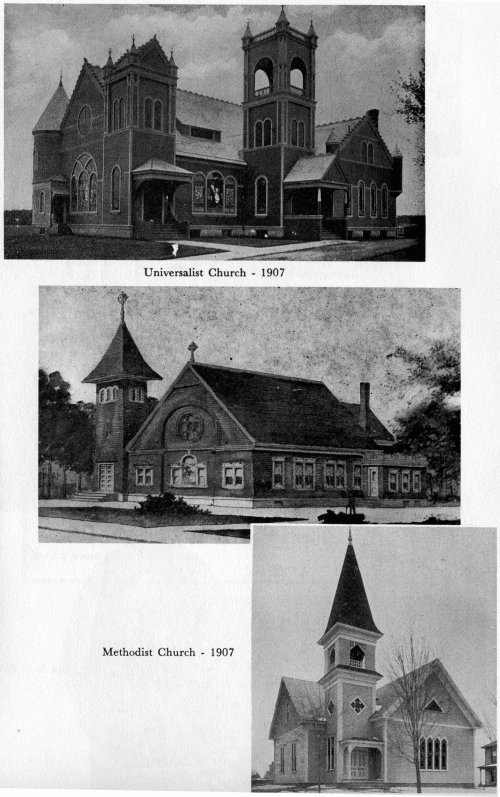
[Page 104.1]
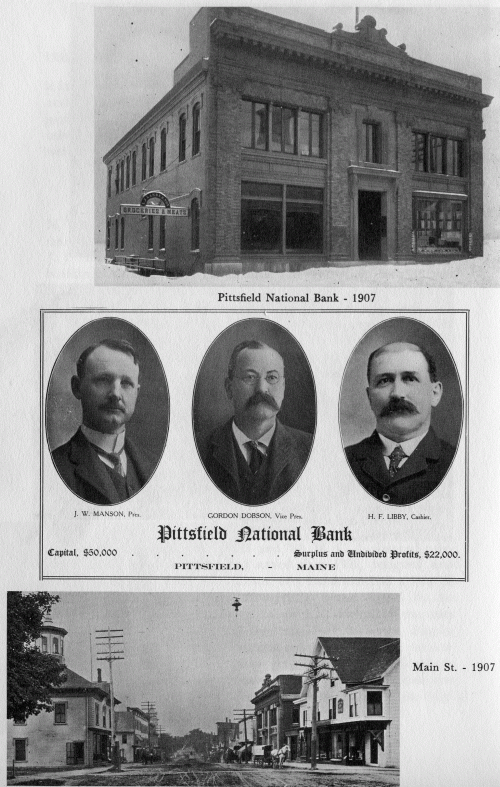
[Page 104.2]
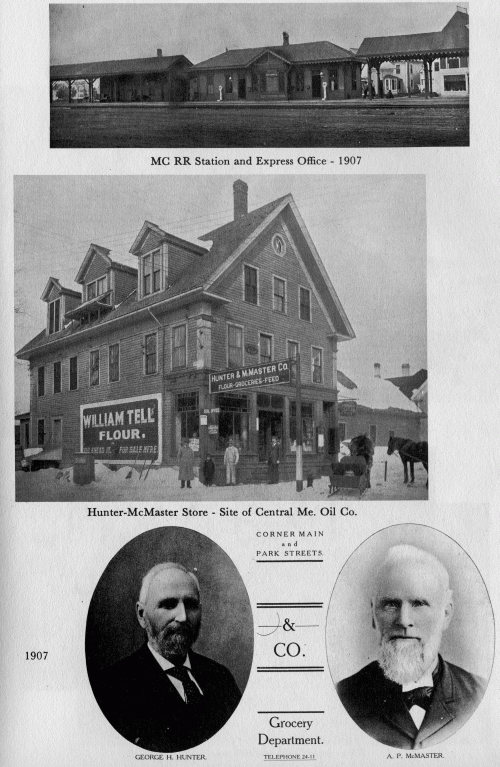
[Page 104.3]
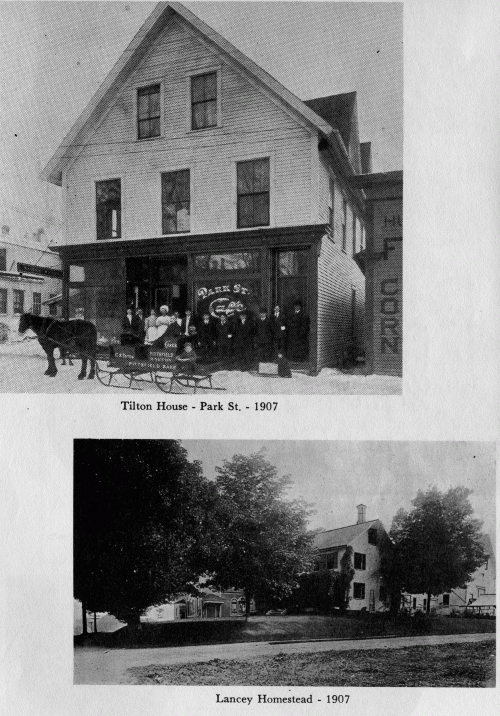
[Page 104.4]
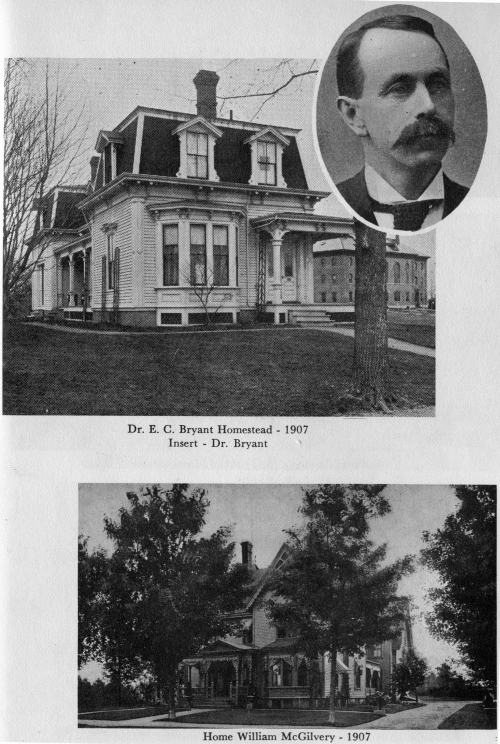
[Page 104.5]
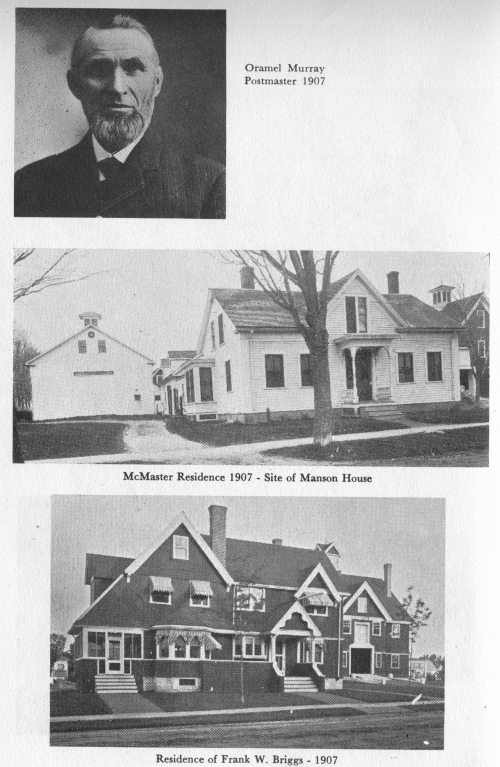
[Page 104.6]
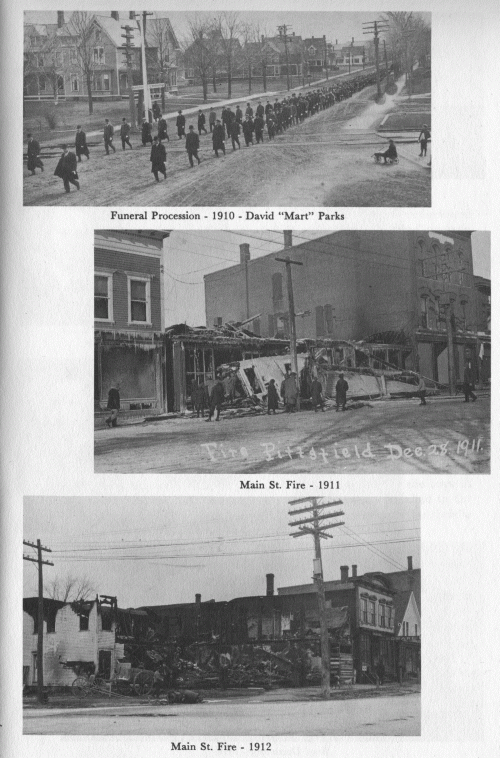
[Page 104.7]
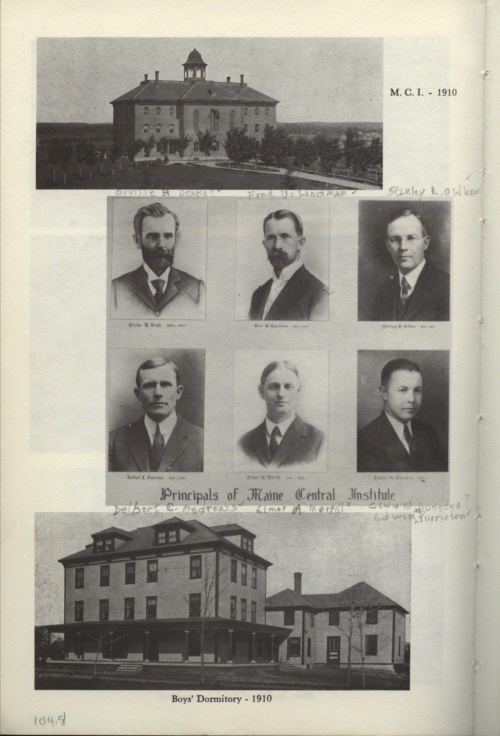
[Page 104.8]
original M. C. I. Alma Materlines that have since become the school hymn. Like Mr. Landman, Mr. Oldham came to be loved and respected by townspeople and students alike.
Once more fire struck the west side of Main Street, this time at the corner of Park Street, leveling another Connor block, taking L. L. Libby’s store and Dr. Damon’s office.
WORLD WAR I
In 1917 and 1918, the big story was the war. It overshadowed other events, even the bankruptcy of the Pittsfield Trust Company which in any other year would have been a shattering experience but now made headlines for a few weeks and then was lost in the welter of war news. The fact that the Four County Fair Association was in financial trouble, that the American Woolen had purchased the Riverside Mill to become sole owner of all our textile plants, that Ray Shepard had coached a championship basketball team, that George Parks had sold a million dollars of life insurance annually for twenty consecutive years, and that Hollis Stitham had leased the Bijou theater from Andy St. Ledgerall these events of 1917 faded into insignificance in the face of the draft call in June for all young men between the ages of 21 and 35. The troop trains, the letters home from the training camps, the bond drives, the Red Cross headquarters where packages were wrapped, sweaters knitted, and medical supplies prepared these were the important stories of the day.
In May of ’18, there was a tremendous send-off for the boys. A parade, led by the band and the Sons of Veterans, marched to the station where Principal S. R. Oldham spoke eloquently but briefly to a company of Pittsfield’s finest.
After Armistice Day and the unrestrained celebrations, official and unofficial, Pittsfield adjusted unusually well to the normal pursuits of everyday living. Some of the boys were delayed in their release from the army and wrote rather emotionally about the red tape and fouled up transfer orders, but eventually they all got back and many of them enrolled in M. C. I. They were a rather wild bunch, naturally, and some of them got mixed up in a hazing scrape that resulted in one or two suspensions, but by the end of
105
the school year things had calmed down and campus talk centered around the achievements of Clarence Emery and Clarence Day in track.
One of the first things the veterans did was to organize an American Legion post. It was named in honor of Otis M. Vining, one of the hoys killed while in the service.
100TH ANNIVERSARY
The big event of 1919 was the Centennial celebration in September. A Centennial Committee was chosen consisting of T. G. Lancey, J. W. Manson, H. R. Coolidge,. Ray Badger and James Halliday. Sub-committee chairmen: Parade, William McGilvery, A. T. Spaulding, Mrs. L. G. Milliken; Decorations, Russell Craig, Edith Burns; Literary Committee, J. W. Manson, Mrs. O., H. Drake; Antiques, H. R. Coolidge, Mrs. Florice Marden; Streets and Police, John M. Lindsay; Music and Dancing, William Bigelow, J. D. Wentworth; Rest Rooms, Rev. H. M. Ford, Rev. S. J. Willis, Rev. D. P. Pelley, Fred D. Cassavant; Publicity, T. G. Lancey, Mrs. Anne Farrington; Welcome to Soldiers and Sailors, C. A. Stevens, Mrs. J. N. Tarbell; Unveiling Tablet, E. P. Bottomley; Old Home Week, Mrs. Nellie Hunnewell.
The town was in holiday attire. The stores and residences were handsomely decorated with flags and bunting to welcome a big historical, industrial, and patriotic parade of four bands, beautiful floats, and decorated automobiles. The parade started at 11 o’clock from the M C. I. campus, down Main Street to Waverley Avenue, Hartland Avenue, Park Street, back to Main Street to the Library where the dedication of a memorial tablet to the veterans of World War I was held.
At these ceremonies, the presentation was made by Principal S. R. Oldham; Unveiling of tablet, Geraldine Cargill; Acceptance of tablet, 1st Lieutenant Charles E. Hartford; Prayer, Rev. H. M. Ford; Presentation of flag to Otis M. Vining Post of the American Legion, Capt. William Ross, veteran of Civil War; Response, Ernest S. Knowlton, Post Commander; “The Star Spangled Banner”, Pittsfield Band.
The parade was made up of six divisions: Division A, Advance Aide, Neil D. Stanley; Chief Marshal, L. C. Taft; Division
106
B, Marshal, Capt. William-Ross; Division C, Marshal, Charles A. Stevens; Division D, Marshal, Everett D. Call; Division E, Marshal, E. Waller.
In the afternoon there were games and athletic events at the Four County Fair Grounds as well as a fine program of harness racing, featuring horses from the W. R. Cox stables in Dover, N. H.
The centennial program was brought to a close with an evening program at Union Hall. Hon. J. W. Manson presided, Mrs. Lilian Drake gave a very interesting history of the town, and there was a vocal solo by Dorothy Drake Haseltine. Governor Milliken’s train was an hour late and Mr. Manson kept the crowd entertained by calling for volunteers who were warmly applauded. Governor Milliken gave an interesting address and a centennial poem by Mrs. Alma Pendexter Hayden was read by Mrs. Blanche Robinson Getchell.
PITTSFIELD
Afar, across the hundred years,
We see thy sturdy pioneers,
Whose toil and foresight not in vain,
Reared Pittsfield in the heart of Maine.
And all along thy growth we trace,
In ever onward, upward pace,
Till Industry and Learning meet,
In every needful way complete.
In all the wars, at bugle call,
Thy boys responded with their all;
Mothers and Sons, thy noble brave,
Freely their best and dearest gave.
Of this past century, a part
Is mine to hold within my heart;
Thy love of home is treasured deep,
And lessons learned are mine to keep.
107
A Mothers voice to us so sweet,
Children along the village street,
Loved faces we no longer see,
In memory come back to me.
And in the throng of Old Home Week
The loved and lost I glad would seek,
If but to find, take by the hand,
And say the words they understand.
Dear Pittsfield, though thy children roam.
In distant lands afar from home,
They still in fancy walk thy ways,
With comrades of the old-time days.
Pittsfield a name to conjure by,
We see thy fields and sunny sky,
And care-free youth returns to all
When once thy magic name we call.
Alma Pendexter Hayden
The Centennial was a success. Although the register did not show all out-of-towners, there were 539 names of visitors from 70 towns and cities. Every New England state was represented and there were many reminiscences exchanged when these good people came together, many for the first time in years. Edward S. Dunton, who had taught in Pittsfield more than fifty years before, was present to meet many of his old pupils. He was a guest of the Higgins family. Mrs. R. F. Garland of Somerville, Mass., recalled that her father, Andrew Philbrick, hung the first bell in the Universalist Church. Marion and Gwendolyn Sinclair of Dexter were interested in looking over the Universalist Church which their grand- father, Fred Hatch, had built.
These occasions are wonderful for those who are fortunate to live to attend them and meet childhood friends. We hope that the 150th Sesquicentennial in 1969 will be equally successful.
Over the next few years, life in Pittsfield settled into a pleasant routine that was carefree but not particularly stimulating.
108
People seemed to be concerned more with personal affairs than community progress. It was a good town in which to live and play. The lurid tales of the roaring twenties could not be used to describe life in the Sebasticook Valley, although there were now and then problems created by prohibition. Life was good and a lot of fun. We had a town basketball team made up of Badger, Dobson, Lanpher, Tarbell, Martin, and Manager Smiley that met and defeated most of the nearby aggregations.
Mr. Oldham left M. C. I. in 1920 and Del Andrews took over the reins. He ran a rather austere program that was probably good for the intellect but not fully appreciated by the student body and some of the parents. When he clamped down on evening study hours for the town students, a great uproar arose and enforcement became quite a problem.
HATHORN PARK
Clyde Martin did a good job in proposing a public park on the old Hathorn estate. It took nearly a year to sell the idea to the townspeople, but he kept at it and raised enough money to develop our first municipal park that today is the center for band concerts and Little League ball games.
In 1920, Irving Whitman became editor of The Advertiserand remained with the paper until he retired recently. Mr. Whitman was a conscientious publisher and one of the finest printers in the business. Before taking over the paper he had served an apprenticeship in Augusta with theKennebec Journal.
Automobiles were becoming more and more common and in 1922, Earle E. Friend, who had been associated with the Friend and Friend garage in Newport, opened a branch in Pittsfield in a building that had once been a carriage shop on the site of the Public Library and had been moved to a location in back of the McGilvery home. As the business prospered, the old building was replaced by the brick structure that today houses the Pittsfield Motor Sales.
This same year Charles Bussell became Postmaster. The Post office was located on the east side of Main Street in the Lancey Block, formerly the main house of the Hathorn estate. The block
109
was severely damaged by fire in 1926 and when Niman Karam built his one-story brick block across the street, the Postoffice was moved into the north half of the building and remained there forty years, moving out in 1966 to their new location on the corner of Central and Hathorn streets.
Other events in 1922 included the purchase of the Hunnewell property on Central and Middle Streets by E. E. Merrill & Son who operated a grain store. A Business and Professional Women’s Club was organized and the ladies were greatly encouraged in this effort by an attractive young businesswoman from Skowhegan by the name of Margaret Chase, who was active in the state organization. From that day to this, Margaret has always been keenly interested in Pittsfield and as U. S. Senator has visited here many times.
In September of 1923. The Elizabeth Pierce Lancey DAR placed a marker at the old Moses Martin homestead, commemorating it as the first frame house to be erected in Pittsfield. I have often taken visitors to this historic site to show them this marker and point out the advantages the location offered to early settlers. Since the Burnham dam was built, these acres are often overflowed during the spring freshets, but in the days of Moses Martin the fine rich bottom land seldom, if ever, was bothered by high water. If the reader will study the 1860 surveyors map, he will notice that there were other farms along the south bank of the river below the Martin place.
A Community Hospital was opened in 1924 on North Main Street at the old Larrabee place, now owned by Frank Hesdorfer. It was a small unit but did a fine service while it lasted. Dr. Blanchard and Dr. Trickey were closely associated with the hospital and the Tuesday Club assisted generously. Like so many nonprofit enterprises, it had financial difficulties and after a brief but useful life was unable to survive.
Town affairs were beginning to stir up a lot of interest during the middle 20s. Harry Thurlough was an active candidate for First Selectman and he put on an aggressive campaign in the papers, on the street, and out through the country. Some of these town meetings were the liveliest and the largest that this writer has ever seen. In one election, before the Australian ballot was adopted,
110
ramps were erected from the balconies to the main floor to accommodate the voters.
At the 1924 town meeting, new bylaws were set up for the Water Works. The year before there had been a big shakeup in the Water Works Department, resulting in the resignation of all three members of the Board and the election of H. N. Fernald, H. H. Jacobs, and C. C. Merrill. Ray Badger was then elected Superintendent of the Water Works. This position combined with his office of Fire Chief made Mr. Badger an influential figure in town affairs.
Other events of interest in this year was the purchase of a new fire truck for $5000, landscaping Union Hall grounds, new sidewalks from Dr. Blanchard’s to the bridges, and the organization of a boys’ band. Frank Fairbanks was the inspiration for this very worthy contribution to the community. The boys made many successful appearances in Pittsfield and the surrounding areas and many of them continued their interest in music in adult life.
The colorful career of Dr. T. N. Drake came to an end in 1924 and his passing was mourned by a wide circle of friends throughout Maine. In his later years, he had given close attention to his practice of medicine and was highly respected as a capable physician.
As the year ended, E. E. Hanson purchased the E. N. Shaw building on Park Street for his White Star Laundry. This building had been occupied continuously since 1882 when it was built by Mr. Shaw and O. S. Haskell to house The Pittsfield Advertiser. After the sale, Mr. Shaw bought Dr. Drake’s offices which he occupied until his death.
In 1925, M. C. I. again changed principals, electing E. M. Purinton to replace Mr. Andrews. Sanger M. Cook was made Assistant Principal. This arrangement turned out to be a very happy one and lasted until 1942 when Mr. Cook resigned to enter the insurance business. Mr. Purinton came to M. C. I. from classroom teaching in Springfield, Mass., and immediately proved his worth as an able administrator and a progressive educator. Under his leadership M. C. I. prospered and gained in prestige.
In July, Pittsfield had the honor of entertaining visiting governors from fourteen slates. They came at the invitation of
111
Governor Brewster and on their trip to the Moosehead Lake country, they stopped in Pittsfield where they were warmly welcomed on the M. C. I. campus. The Reception Committee consisted of Mrs. L. G. Milliken, Mrs. Nellie Hunnewell, Mrs. William McGilvery, Mrs. J. W. Manson, and Mrs. Henry Libby. Mr. Thurlough, as First Selectman, welcomed the governors on behalf of the town. The large crowd that filled the campus reminded many of the time that Thomas B. Reed spoke from that same spot many years before.
Among items of unusual interest this year was the visit of Dr. V. T. Lathbury of Augusta, formerly of Pittsfield, who was called to attend S. M. Raymond. It was an emergency and Dr. Lathbury flew from Augusta to land in a field east of McCarthy Hill. It was the first occasion that an airplane had been used for a medical call in this area.
M. C. I. had a most successful football season and the Universalist Men’s Club gave the team and their coaches, Mr. Dow and Mr. Cogan, a wonderful banquet and presented the school with football blankets.
The following year (1926), M. C. I. had an even more successful season, winning the state championship and this time the players and coach were presented gold footballs at a Chamber of Commerce Banquet at the Universalist Church. This was a most auspicious beginning for Roy U. Sinclair, the new young coach just out of Bates College. A write-up of the banquet mentions that Pig Luttrell led the squad in a heavy attack on each and every course as it came along; that snappy tunes were rendered by Shoreys Orchestra, and that Rev. Walter Quarrington amused all with his story of Johnson’s ghost. The evening was concluded at the Bijou Theatre where Red Grange was featured in One Minute to Play.
During February 1927, M. C. I. displayed its musical talent over WCSH at Portland. Barbara Kimball, Elizabeth Coffin, Alice Murch, Gardner Burns, Clyde Woodward and their instructors Miss Estelle Baumann and Mrs. Ruth Cook presented a program that was applauded all over Maine. The Chamber of Commerce set up a special receiving set in the Lancey House and sent telegrams that were read over the air.
112
In July of 27, Pittsfield held a tremendous Dollar Day and Street Dance, featuring Maine’s famous fiddler, Mellie Dunham and his wife, Gram.
The following month another entertainment feature relating to Pittsfield took place in Skowhegan when the Lakewood Theater presented Arba Gene Powers in Alias The Deacon. Mr. Powers, a direct descendant of the famous Powers family of West Pittsfield, had become a well-known Broadway star and thrilled many patrons during his week at Lakewood.
There were two changes affecting church life in Pittsfield this year. The St. Agnes became a separate parish with Father Ballou serving as the first resident priest; and Rev. Milo G. Folsom and his wife, Rev. Josephine Folsom, accepted a call to the Universalist Church. They served a long and useful ministry. Following Mr. Folsom’s death in 1939, Mrs. Folsom accepted the pastorate.
As the year ended, there were rumors and much foreboding concerning the future of the woolen mills. For quite awhile, work had been intermittent in the Waverley and Riverside and several families had been forced to look for work outside Pittsfield. World-wide conditions were not good, particularly in the textile field, and what the future held, no one knew. The woolen mills had long been accustomed to seasonal shutdowns, but of late these layoffs had occurred more frequently and were of longer duration. It was disturbing.
A real disaster hit M. C. I. during the Christmas vacation—the boys’ dormitory was completely destroyed by fire. When the new year opened (1928), the boys were placed in homes adjacent to the campus and in spite of the inconveniences went through the winter and spring terms with flying colors.
ALUMNI HALL
The ashes of the old dorm had hardly cooled when a meeting of the Board was called and plans were started to rebuild. There was considerable discussion as to the type of dormitory to build, but it was finally decided to design it with suites rather than the conventional type with rooms opening into a hallway. The
113
Alumni were aroused and from all parts of New England came messages of encouragement.
The Alumni Association took a very active part in raising funds and as a result of their efforts, the new dormitory was named Alumni Hall. The officers of the Association were President, Mary Spear; Vice President, E. N. Vickery; Secretary, Bessie Maloon; Treasurer, Grace Cook. The Executive Committee was made up of Sadie McCrillis, Hazel Severance, and Vernon L. Shorey. Sadie McCrillis was Chairman of the Pittsfield Alumni drive.
By early spring, the dormitory was assured and at the June Commencement the cornerstone was laid. After a slight delay in the fall, the building was ready for occupancy and proved to be all the Trustees hoped for. Official opening ceremonies were held in October.
There were not many changes in the business life of the town during 1928. A gas and fuel oil company was organized by J. E. McMichael, H. F. Walker and Ralph Cianchette. Their offices were located in the Hotel Garage at the rear of the Lancey House. This was at one time the headquarters for Col. Morrill and his livery stable. As long as the Colonel was alive, he had the use of his old office and many an interesting session was held there, discussing town politics or listening to the Colonel reminisce about Civil War days. One of his favorite stories was how he was wounded in the Battle of the Wilderness and lay for hours on the battlefield expecting to die. In the course of the tale he would usually open his mouth and steer a listeners finger to a large hole in his jaw where a mini ball had lodged. By Godfrey, it hurt more when it come out than when it went in! the old Veteran would exclaim.
In December of 28, Hubbard’s Garage was leveled by fire, later to be replaced by a much finer building that greatly improved the entrance to the village.
Although the year of 1929 saw the beginning of a depression that was to change the lives of millions of Americans, there was little in Pittsfield to indicate the seriousness of things to come. Work in the mills continued to be slack, but the attitude seemed to be that it was disturbing but it had happened before and
114
eventually it would all straighten out. Of course, it would have been nice if the Dobsons were around to talk to and find out what it was all about. It was almost impossible to believe that the end of the textile business was near at hand. The three big mills had been here so long that they were a part of the scenery; they were taken for granted and the thought of them closing down for good was almost fantastic. A similar attitude prevailed years later when the railroads gradually closed out their passenger service.
This gloomy atmosphere did not discourage Farrar’s Furniture of Bangor from opening up a branch store on Park Street with Frank Brown as manager. Neither did it deter the management of the Bijou theater from spending money to bring talking pictures to Pittsfield. The first show was The Barker starring Milton Sills.
When Miss Effie Lord of Detroit resigned as teacher at the Lancey Street School after twenty-three years of continuous service, many young men and women who had gone to school to her felt a tinge of sadness. She was a devoted teacher of the old school who believed in thoroughness and strict attention to duty.
As we look back on the past thirty years, perhaps Complacency is not the correct term to characterize the era. It was interrupted by a war; it was disturbed by several major conflagrations; and toward the end, it was threatened by a severe depression. However, if we compare the last twenty years of the 19th century with the first thirty years of the 20th, it is very evident that something must have happened besides a few economic setbacks. Oftentimes a disappointment or even a disaster results in renewed vigor. This evidently was not the case in Pittsfield. According to the Maine Register, our population in 1880 was 1909. By 1900 it had reached 2891, an increase of 33%. From 1900 to 1930 when our population was 3075, our growth rate was .05%almost nil! What caused this slowdown? Perhaps it was a state of mind—an attitude of complacency we mentioned at the beginning of the chapter. It is exemplified in the community reaction to the Lancey House fire in 1906.
For nearly five years, this grand old building lay in ruins and nothing was done about it except to cuss it out as an eyesore. Can we imagine this happening if Isaac Lancey had been alive?
115
As events unfolded, Pittsfield was in for some hard times in the next few years and like a lot of other communities, the town was not prepared for it. Yet there was one asset that had been overlooked in those years of marking time. The Italian population that had settled in the western part of the town thirty years ago had been working hard, had acquired land, had become adjusted in their new homes. Many of them had gone into contracting, a field in which they seemed to have a natural talent. The jobs that they took were small at first, but they increased as years went on. Some of them had moved into the village and their sons and daughters were in M. C. I. and doing very well. There was a spirit in this group that reminds one of the spirit of our earlier pioneers. Their contribution to our return to prosperity can never be erased from the records of Pittsfield.
116
|